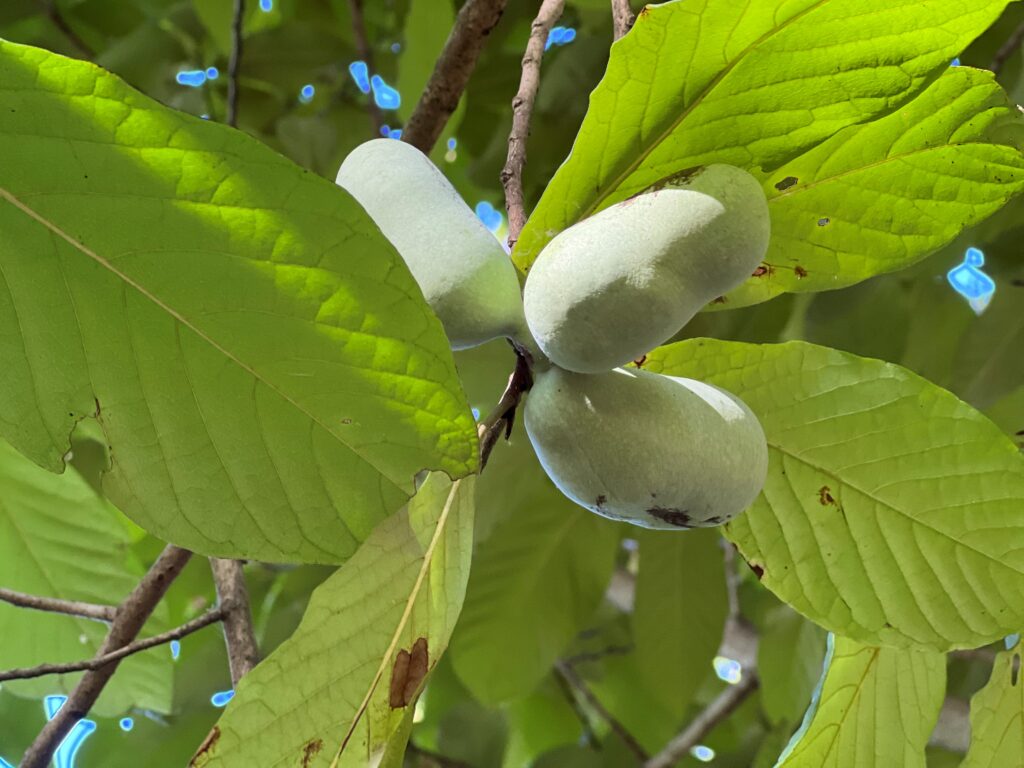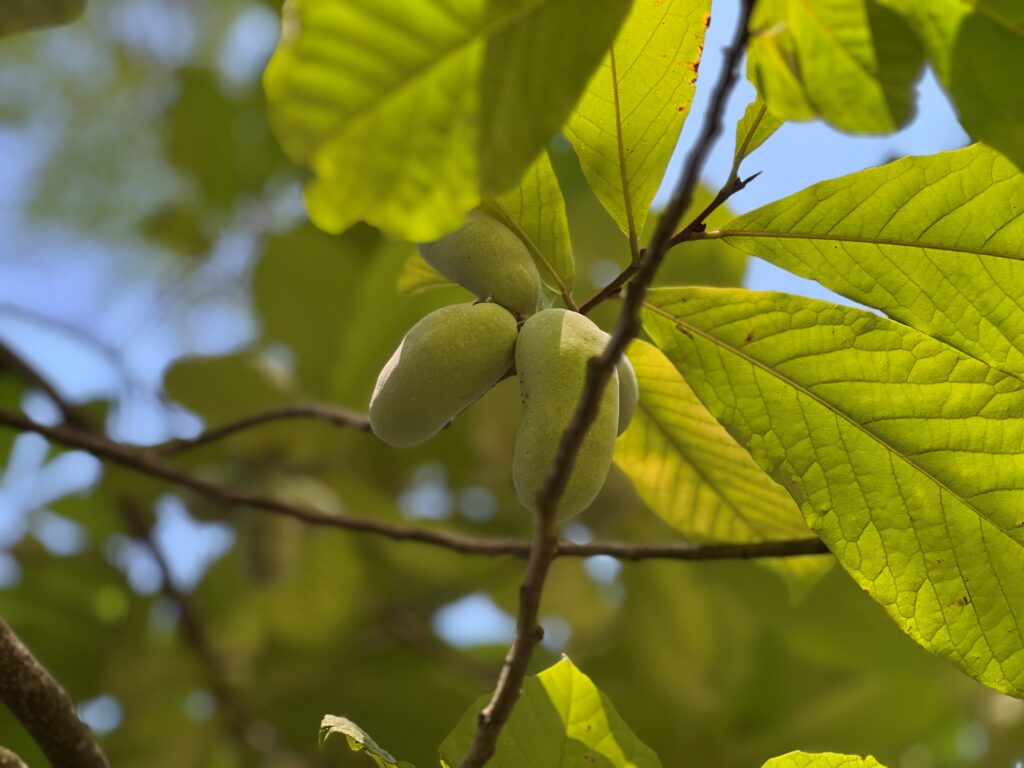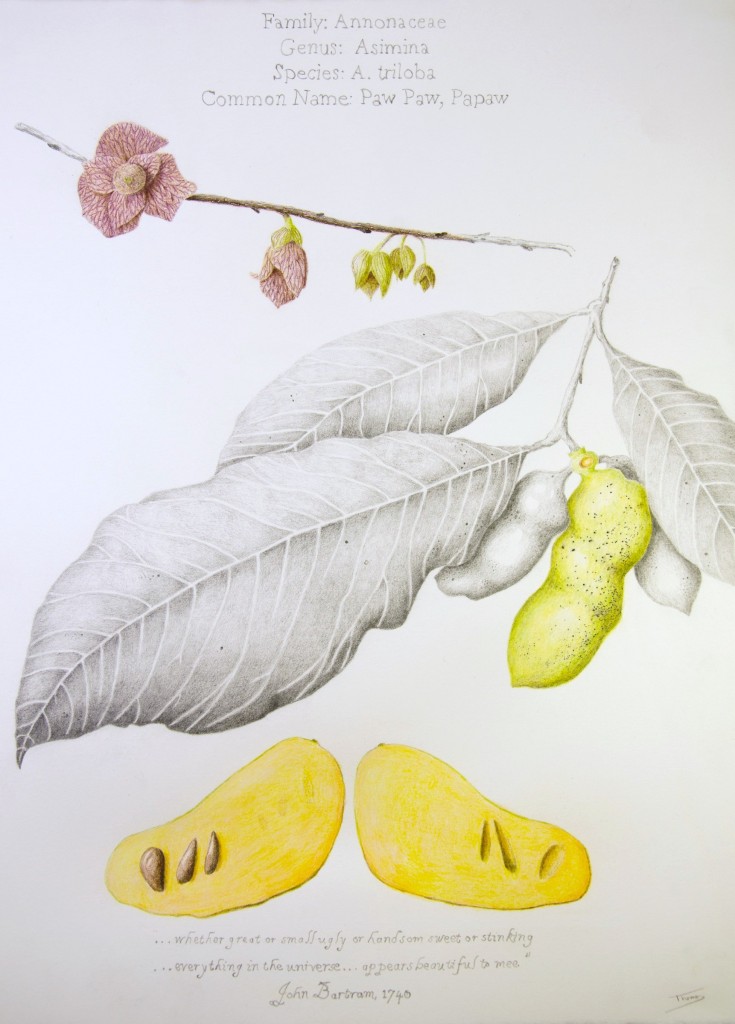All About Pawpaws
Nestled on the edge of the Children’s Garden, just across from the sand box, stands a tree with broad green leaves and clusters of oblong fruit growing from its branches: the pawpaw (Asimina triloba). Native to Virginia and portions of 25 other states, it’s a favorite of foodies who eagerly await the end of summer when pawpaws are ripe and ready for foraging. “The flavor is really unique, a mix between the tropical taste of a mango and more earthy taste of a banana,” says Dean Dietrich, Horticulture Section Leader here at Lewis Ginter Botanical Garden. Eager to try it? Here’s everything you need to know about finding, foraging, and cooking with pawpaws.
What are pawpaws and where do they grow?
Pawpaws are native deciduous understory trees, commonly found along rivers in moist soil. They’re smallish in size and tend to sprout in colonies (a.k.a. pawpaw patches). “In the Richmond area, you’ll find wild pawpaws growing all along the James River,” says Dietrich. “The leaves are alternate and secrete a pungent smell when crushed. In the spring, six petaled purple-brown flowers appear and are pollinated by flies.”
Pawpaws produce the largest edible fruit of any tree native to North America. Oblong in shape and born in clusters of two to five, pawpaw fruit grow to be between two and six inches long, and about one to three inches wide. Beneath the skin, pawpaw flesh can range in color from white to yellow to orange, with large, hard black/brown seeds that should be removed before eating.
It’s believed that pawpaws have been in North America for hundreds of thousands of years, enjoyed by early ancestors and cultivated by Native Americans. Lewis and Clark recorded eating them during their expedition, and George Washington planted pawpaws at Mt. Vernon. Illustrated pawpaws appear in John James Audubon’s Birds of America, have been written about by poets including Walt Whitman, and there are even towns named for the pawpaw in West Virginia, Kentucky, Michigan, and other states where the tree grows.
How can I tell when pawpaws are ripe?
Pawpaw fruit ripens between late August and late September, depending on the region. “You’ll know the pawpaws are ripe when the skin has turned from green to a yellowish-orange color,” says Dietrich. “One of the easiest ways to forage for pawpaws is to give the tree a gentle shake. The ripe fruits will fall to the ground. If fruit is not quite ripe, let sit on a windowsill in the sun until it is ready to eat.”
What do pawpaws taste like and how do you eat them?
Pawpaws have a distinct, tropical flavor, like a delicious mash-up of a banana, mango, pineapple, and cantaloupe, with notes of chocolate and nuts. Texture-wise, the flesh is thick, creamy, and custard-like. After removing the skin and the seeds, the pulp can be eaten raw, or used to make chilled treats like pawpaw smoothies and ice cream. It can also be mashed or pureed to make pawpaw bread, a sweet-but not-too-sweet treat that’s similar to banana bread in consistency.
PAWPAW BREAD RECIPE
Prep: 15 Minutes
Cook: 50 Minutes
Servings: 1 Loaf
Ingredients:
½ Cup Butter
1 ½ Cup Mashed Ripe Pawpaw Fruit (seeds and skin removed)
2 Large Eggs
1 Teaspoon Vanilla Extract
2 Cups All Purpose Flour
1 Cup Granulated Sugar
1 Teaspoon Baking Soda
½ Teaspoon Salt
½ Teaspoon Cinnamon (optional)
Method:
- Preheat oven to 350 degrees. Grease a standard 9×5 loaf pan with butter and set aside.
- Add portioned/softened butter to a mixing bowl with mashed pawpaw, vanilla, and egg. Mix until fully combined and no streaks of egg remain.
- In a second bowl whisk together the flour, sugar, baking soda, salt, and cinnamon.
- Add the dry ingredients into the wet ingredients and mix with a spatula just until combined.
- Pour the batter into the prepared load pan and bake for 45-55 minutes until a toothpick inserted into the center of the quick bread comes out clean.
Recipe courtesy of Executive Chef Jared Serr, Restaurant Associates at Lewis Ginter Botanical Garden
How do I find out more about pawpaws?
Attend a festival like the Butterfly Society of Virginia’s Pawpaw Festival in August (pawpaws are a favorite of zebra swallowtails) or Ohio’s Pawpaw Festival in September. You can also pay a visit to Lewis Ginter Botanical Garden’s Lora M. Robins Library to explore titles (including sources for this story) like:
For the Love of Pawpaws: A Mini Manual for Growing and Caring for Pawpaws by Michael Judd
Pawpaws: The Complete Growing and Marketing Guide by Blake Cothron
Pawpaw: In Search of America’s Forgotten Fruit by Andrew Moore


